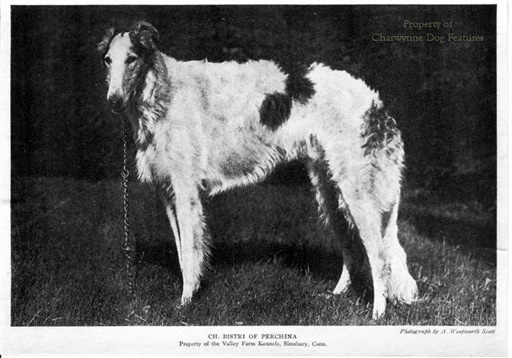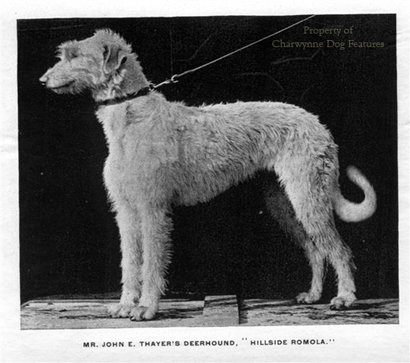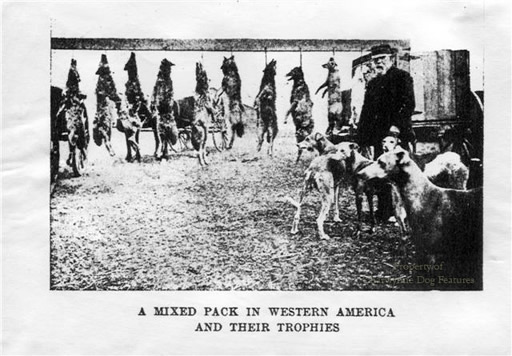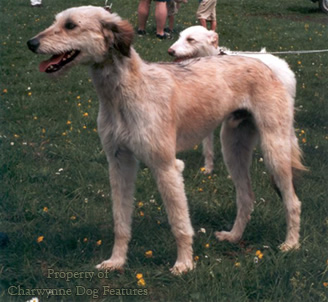667 Yankee lurchers
YANKEE LURCHERS
by David Hancock
 The lurcher function in the United States is mainly carried out there by what is known as Staghounds, big rough-haired crossbred dogs, crossbred in pursuit of function not whim, although personal preferences do manifest themselves in conformation. There is an even stronger tradition there too of bobbery packs, a collection of coarsely-bred hounds brought together 'to go hunting'. In his Hunting Dogs of 1909, (Harding Publishing Co of Columbus, Ohio) Oliver Hartley writes: 'I am a farmer by trade and a racoon hunter for sport, and nothing but a foxhound (a hound used on fox, not our Foxhound, DH) for me, and the better his breeding is the better I like it. I don't care how much noise he makes if he is fast. I like a good tonguer. I only have four hounds at this writing. I have caught 27 'coon and 10 opossum. On the night of November 9th, some friends of mine went out 'coon hunting with me. They had three 'coon dogs and I had four, seven hounds in all. We went about two miles south of where I live to where we sometimes hunt the 'coon.'
The lurcher function in the United States is mainly carried out there by what is known as Staghounds, big rough-haired crossbred dogs, crossbred in pursuit of function not whim, although personal preferences do manifest themselves in conformation. There is an even stronger tradition there too of bobbery packs, a collection of coarsely-bred hounds brought together 'to go hunting'. In his Hunting Dogs of 1909, (Harding Publishing Co of Columbus, Ohio) Oliver Hartley writes: 'I am a farmer by trade and a racoon hunter for sport, and nothing but a foxhound (a hound used on fox, not our Foxhound, DH) for me, and the better his breeding is the better I like it. I don't care how much noise he makes if he is fast. I like a good tonguer. I only have four hounds at this writing. I have caught 27 'coon and 10 opossum. On the night of November 9th, some friends of mine went out 'coon hunting with me. They had three 'coon dogs and I had four, seven hounds in all. We went about two miles south of where I live to where we sometimes hunt the 'coon.'
In those few words he sums up the global farmer-desire to go hunting with a few functional hounds, in his case 'treeing hounds'. Hartley refers to a Minnesota wolfer who averaged 35 wolves a year and who pinned his faith in the long-eared variety of hounds, with features of strength, endurance, good tonguers and stayers. He had been advised that the best dogs for coyotes, are part English blue (Greyhounds, DH) and Russian stag (Borzois, DH). He wrote that the English blue are very fast and the stag are long-winded, with the grit to make a good fight. He wrote that another admired and capable dog is the one-half Scotch stag hound (Scottish Deerhound, DH) and one-half Greyhound. He recorded that a Wisconsin hunter believed that the best breed to catch and kill coyotes are one-half shepherd (our collie) and one-half hound, being faster than a hound and trailing just as well on a hot trail. He wrote too that another fast breed for coyotes is a one-fourth English bull, one-fourth Bloodhound and one half Foxhound. Here is a classic example of blending blood in pursuit of performance, the lurcherman's endless quest.
In his book The Gun Digest Book of Sporting Dogs, (DBI Books, Inc, Northbrook, Illinois, 1984), Carl P Wood writes: 'Many other breeds and crossbreeds are used to hunt foxes. Many of these are regional breeds generally used only in one area. They were developed by persons living in that particular area to meet the specific needs of local hunters. These local breeds are not recognised by any official registry, but this does not mean that they are any less efficient or capable at the job for which they were bred. There are yellow tics, fices, an old breed known as the cur dog, boomers, mountain hounds and many breeds with which I am not at all familiar. In some parts of the country the coursing breeds are used as fox and coyote dogs.' He would have warmed to the lurcher scene in Britain; the concept that hunting dogs, however efficient in the field, are somehow lessened in value by being unrecognised and unregistered, is a seriously flawed one. Pedigree dog breeders in so many countries have closed minds and so often lack experience with sporting dogs in the field.
In his book Lurchers and Longdogs, Ted Walsh mentions the Nebraska coyote hound, 29½" at the shoulder and weighing 90lbs. He quotes from a Minnesota report on the American houndman which states: 'He merely breeds one good hound to another regardless of background...the basis of the American lurcher is the greyhound crossed first with the Scottish deerhound; secondarily with the Irish Wolfhound and Borzoi; rarely with the whippet or saluki. This breeding pattern may be explained by considering the game coursed in North America, the hare (jack rabbit), red fox and coyote.' This report sets out the use of 'cold blood' or coursing greyhound on hare, a rougher-coated hound on red fox and the emergence of an American Coyote Hound, 75 to 100lbs, with a Deerhound coat. But it stresses that no kennel there was raising either Deerhounds or Borzois primarily for hunting. The Whippet was recommended for the cotton-tail rabbit, lacking the stamina for the jack rabbit.
An earlier book, Observations on Borzoi by Joseph B Thomas, Houghton Mifflin, Boston and New York, 1912, mentions 'turnits', hounds which never run directly after the rabbit, but try to outflank it, taking short-cuts to anticipate its intended course. For this they are disqualified from coursing meetings, yet admired for their guile. Interestingly, Thomas points out that 'the American conditions of hunting are most severe on the hound (he means longdogs), because he usually has a tremendously long run to overtake this quarry (i.e. coyotes and wolves), who almost invariably has a good head start, and is at best a very swift animal.' He stresses the vital importance of condition in hounds used on coyote and wolf, advising careful feeding, graduated schooling with other skilled animals and a build-up of exercise before hunting.
Thomas considered that puppy-schooling was vital for coursing dogs, with early and gradual conditioning essential, giving the view that 'I do not believe that any hound that has not worked in puppyhood can possibly acquire, after he has reached the age of one or two years, sufficient staying power and love of the game ever to become really good'. It is worth noting his stressing both stamina and keenness to hunt. He emphasised the importance of matching breeding, training, condition and experience in the making of a good coyote or wolf dog. He wrote: 'There are not many hounds of any breed that will tackle a coyote or wolf without proper training; and without exoerience, it can be said that it is impossible for any hound even to catch a coyote. Most Western wolf-hunters have packs of hounds, picked up here and there, that are kept merely because of their peformances, regardless of their breeding, shape or color'. Sounds like a sensible lurcherman!
He concluded by writing: 'These hounds, which run loose all year, traveling at times sixty to seventy miles a day, are of all sorts of coursing blood, greyhound, deerhound, and Borzoi. The conditions of coursing wolves or coyotes are most difficult. In places the country is very rough, and the coyote generally gets a long start, sometimes more than half a mile. He is surprisingly swift, so that it takes a good hound to catch him. He is also a surprisingly good fighter, so that it is asking a good deal of any animal in coming, winded, upon a coyote to tackle it'. The ancestors of these dogs would have undertaken the long journey to a new life in America, nearly always from the British Isles; the function of the lurcher was merely transported across the Atlantic. For hunters, America is still the place to be for freedom to continue the sporting pastimes of your ancestors. We have all but lost that freedom.